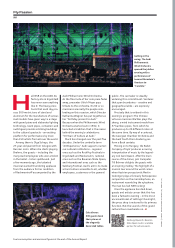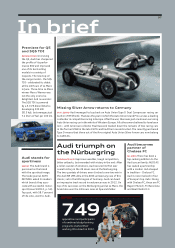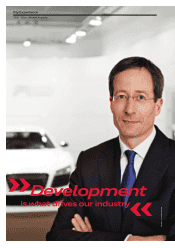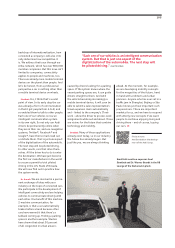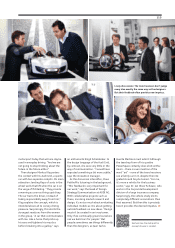Audi 2012 Annual Report Download - page 100
Download and view the complete annual report
Please find page 100 of the 2012 Audi annual report below. You can navigate through the pages in the report by either clicking on the pages listed below, or by using the keyword search tool below to find specific information within the annual report.
Dr. Werner Brandt
is a member of the
Executive Board and
Global Managing Board
and Chief Financial
Ocer of SAP AG. He is
in charge of all financial
activities as well as
the administration of
the German company.
SAP is the world’s
largest supplier of
business software.
professional capacity at SAP. These
days, companies have to handle huge
volumes of data that only have any
value if they can be processed in real
time, wherever you are – mobility
and speed are the top priority today.
Our HANA in-memory technology can
process millions of pieces of infor-
mation in a matter of seconds, up to
100,000 times faster than before.
We can also provide an infrastructure
for exchanging this information on
the move. Employees of companies
all over the world send 1.8 billion text
messages over SAP servers every day.
Strotbek: Mobility and speed – those
two words encapsulate what today’s
global economy is all about. There can
rarely have been a time of such dramatic,
fast-moving change. It’s becoming
more and more dicult to make reliable
forecasts. I view that as a major chal -
lenge. On the one hand there are
critical markets, for instance here in
Europe. On the other hand there are
markets that oer opportunities, such
as in Asia and South America. In Audi’s
opinion the opportunities balance out
the risks. Do you view your industry
similarly?
Dr. Brandt: I have to admit Europe is
very much dominated by uncertainty.
As well as the sovereign debt crisis,
we have a banking crisis on our hands.
In my opinion it is exacerbated by a
crisis spreading throughout the entire
economy, at least in the countries
experiencing problems – and it has been
triggered by a lack of competitiveness
of those countries’ major enterprises.
As a result, Europe is expected to show
only slight overall economic growth
in 2013 compared with 2012. On the
other hand, worldwide growth is running
at some three percent, driven mainly
by the emerging markets and newly
industrialized countries. North America’s
performance is roughly the average for
industrial nations, at 1.5 percent. Much
will depend on the BRIC countries, but
also on the emerging markets in Latin
America and Asia – SAP is focusing very
strongly on those markets.
Strotbek: We can echo that. We are
also placing the focus on growth
markets. China is already our biggest
single market worldwide, with over
400,000 vehicles sold each year. We
are in the process of building a new
plant there with a capacity of 200,000
units, and will soon be ramping up
our capacity in China to 700,000 cars
annually. But we are also expanding
capacity in Europe, and from 2016 we
will have a new manufacturing location
in North America. From then on, all Q5
models sold worldwide will be built
in Mexico. That’s a huge step for us in
internationalization, and obviously a
challenge to keep our flows of currency
and goods in equilibrium.
Dr. Brandt: We believe the emerging
countries are not just markets to sell
our products – we are also able to
recruit highly talented people there.
As a globally active company with
20,000 of our 64,000 employees
working in development, an inter-
na tional, diverse pool of talent is
extremely important. We have 14
strategic development locations
–
Bangalore in India is already the
second-biggest after Germany, then
come Palo Alto, Shanghai and São
Leopoldo in Brazil. In other words,
we use talented people all over the
world to develop our software in a
way that fulfills the needs of our
customers in each individual region,
thus generating maximum added
value for our customers.
Strotbek: We’re very familiar with
that challenge of satisfying the specific
preferences of a rapidly growing
customer base in places such as China
and North America. We run design and
development centers in each of those
regions, mainly so that we can identify
changing market trends rapidly. In our
target markets we’ve also set up what
we call product clinics, where we present
new models, designs and technologies
to selected or potential customers at
a very early stage of the development
process. That way, we very quickly
obtain feedback that we can then act
on in the product development process.
Dr. Brandt: That’s very interesting.
Are you able to identify typical regional
or national dierences?
Strotbek: In Europe, the people who
buy our large models usually drive
Exchanging ideas:
Dr.Werner Brandt
and Axel Strotbek
discuss future trends
in their industries.
103





